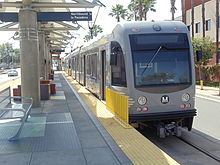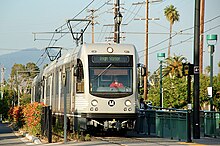L Line (Los Angeles Metro)
These names referred to a single light rail line of 31 miles (50 km)[1] providing service between Azusa and East Los Angeles via the northeastern corner of Downtown Los Angeles, serving several attractions, including Little Tokyo, Union Station, the Southwest Museum, Chinatown, and the shops of Old Pasadena.[1] In October 2020, the line was broken into two disconnected segments with the closure of the Little Tokyo/Arts District station in preparation for the opening of the Regional Connector tunnel.[4] As of that date, passengers may now transfer between the two segments of the former L Line at this station, or stay on board to continue through Downtown LA.From here, the route continued, with a handful of stations serving the hillside communities north of downtown, including Lincoln Heights, Mount Washington, the Southwest Museum of the American Indian.At Union Station, passengers could transfer to the B and D rapid transit lines, Metrolink commuter rail, Amtrak, and buses.Prior to this date, riders seeking to travel between the then disconnected segments of the L Line had to use a temporary bus shuttle to make the connection.The L Line was particularly slow through the Highland Park area, where trains reach speeds of only 20 mph (32 km/h) while operating in a street running section on Marmion Way.Much of the L Line's right-of-way through the San Gabriel Valley was built by the Los Angeles and San Gabriel Valley Railroad in 1885, eventually taken over by the Atchison, Topeka and Santa Fe Railway, as part of the Pasadena Subdivision,[14] which saw Amtrak service until 1994, when construction began on the conversion to light rail.The southern (Pico/Aliso–East LA) segment was combined with the previously existing E Line, which ran between Downtown Los Angeles and Santa Monica.[4] After the Regional Connector opened, the L Line became the first letter designation on the Los Angeles Metro Rail system to be permanently discontinued.Division 11 is situated at the end of 208th Street between I-710 and the Los Angeles River in North Long Beach within the A Line.



Foothill FreewaySierra Madre Villa stationLos Angeles County Metropolitan Transportation AuthorityAPU/Citrus CollegeAtlanticLight railLos Angeles Metro RailSiemens P2000AnsaldoBreda P2550Kinki Sharyo P3010Track gaugestandard gaugeElectrificationOverhead lineAzusa DowntownIrwindaleDuarte/City of HopeMonroviaArcadiaSierra Madre VillaMemorial ParkColorado BoulevardDel MarFillmoreSR 110South PasadenaHighland ParkSouthwest MuseumHeritage SquareLincoln/CypressMetrolinkAmtrakChinatownUnion StationNorth HollywoodWilshire/WesternUS 101RegionalConnectorLittle Tokyo/Arts DistrictPico/AlisoMariachi PlazaIndianaSR 60MaravillaEast LA Civic CenterEast Los AngelesDowntown Los AngelesLittle TokyoOld PasadenaLittle Tokyo/Arts District stationRegional ConnectorA LineE LineAtlantic stationAPU/Citrus College stationAzusa Downtown stationIrwindale stationSan Gabriel RiverDuarteDuarte/City of Hope stationCity of Hope National Medical CenterMonrovia stationArcadia stationPasadenaMemorial Park stationArroyo Seco ParkwaySanta Fe Arroyo Seco Railroad BridgeHighland Park stationFigueroa StreetLincoln HeightsMount WashingtonSouthwest Museum of the American IndianLos Angeles RiverChinatown stationrapid transitcommuter railright-of-wayPasadena Subdivision1st StreetBoyle HeightsPico/Aliso stationMariachi Plaza stationSoto stationEvergreen CemeteryIndiana station3rd StreetMaravilla stationEast LA Civic Center stationPark and rideMontecito HeightsCypress ParkDowntownLAX FlyAwayLittle Tokyo/Arts DistrictLos AngelesHistory of Los Angeles Metro Rail and BuswaySan Gabriel ValleyLos Angeles and San Gabriel Valley RailroadAtchison, Topeka and Santa Fe RailwayBlue LineFoothill ExtensiontunnelLos Angeles Metro Rail rolling stockTournament of Roses ParadeRose Bowl Gamearticulatedpickup truckLos Angeles FireMetro C Linebig rigSierra Madre BoulevardLos Angeles TimesNexstar Media GroupSan Gabriel Valley TribuneWayback MachineBuswayPomona NorthLa Verne/FairplexSan DimasGlendoraHistoric BroadwayGrand Avenue Arts/Bunker Hill7th Street/Metro CenterGrand/LATTC